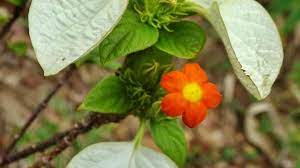About New Plant Species:
- Researchers discovered two new plant species namely Dendrophthoe longensis (from Andaman and Nicobar islands) and Petrocosmea arunachalense (from Arunachal Pradesh).
- Dendrophthoe longensis
- It is an aerial stem-parasitic flowering plant species discovered from the Long Islands of middle Andamans.
- It was found on the specific host plant – Mango, Mangifera indica in the edge of evergreen forests, low land areas of tropical forests.
- The species is from the family Mistletoe – a group of hemi-parasitic flowering plants which exhibit a suite of remarkable adaptations associated with the hemi-parasitic habitat.
- The species is sparsely scattered and confined to a few localities of Long Island.
- Threats: Aerial stem-parasitic flowering mistletoe plants are under great pressure due to destruction of natural habitat and other anthropogenic activities especially timber harvesting of host tree species, developmental works which are causing population declines worldwide.
- Petrocosmea arunachalense
- It is a very small herb and the researchers located it inside a cave indicating that the species requires less sunlight
- The species is completely white with purple blotch and the plant has a hairy texture.
- It is only the second known species from the genus Petrocosmea in India.
What are biodiversity hotspots?
- Biodiversity hotspots are geographic areas with an exceptionally high richness of species, including rare and endemic species.
- Around the world, 36 areas qualify as hotspots. Their intact habitats represent just 2.5% of Earth’s land surface, but they support more than half of the world’s plant species as endemics
- To qualify as a biodiversity hotspot, a region must meet two strict criteria:
- It must have at least 1,500 vascular plants as endemics — which is to say, it must have a high percentage of plant life found nowhere else on the planet. A hotspot, in other words, is irreplaceable.
- It must have 30% or less of its original natural vegetation and must be threatened.
- There are 4 biodiversity hotspots in India namely; Himalayas, Indo-Burma region, Western Ghats and Sundaland.
Q1: What is Parasitism?
It is a relationship between two species of plants or animals in which one benefits at the expense of the other, sometimes without killing the host organism.
Source: Two bio-geographic hotspots in India yield two new plant species
Last updated on June, 2025
→ UPSC Notification 2025 was released on 22nd January 2025.
→ UPSC Prelims Result 2025 is out now for the CSE held on 25 May 2025.
→ UPSC Prelims Question Paper 2025 and Unofficial Prelims Answer Key 2025 are available now.
→ UPSC Calendar 2026 is released on 15th May, 2025.
→ The UPSC Vacancy 2025 were released 1129, out of which 979 were for UPSC CSE and remaining 150 are for UPSC IFoS.
→ UPSC Mains 2025 will be conducted on 22nd August 2025.
→ UPSC Prelims 2026 will be conducted on 24th May, 2026 & UPSC Mains 2026 will be conducted on 21st August 2026.
→ The UPSC Selection Process is of 3 stages-Prelims, Mains and Interview.
→ UPSC Result 2024 is released with latest UPSC Marksheet 2024. Check Now!
→ UPSC Toppers List 2024 is released now. Shakti Dubey is UPSC AIR 1 2024 Topper.
→ Also check Best IAS Coaching in Delhi






















